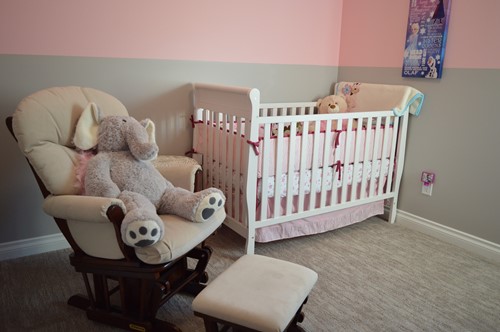Email: [email protected]

When expanding your family, it's always a good idea to consider the space you have available. If you've relocated or upgraded your home office to a new space in the house but still have the remnants of your old office lingering in a decent sized room, you can repurpose it into a baby's nursery. Here are a few key tips to remember if you decide to convert unused home office space into a baby nursery.
When you designed the room to function as a home office, thoughtful consideration was likely given to workspace, storage and seating. In many ways, those same elements are still present in a nursery.
Rethink the baby's crib and changing table as the primary workspace. When aligned side by side, they may take up a similar amount of square footage as a desk. Storage will be necessary for diapers, infant toys and other necessary items. If you'll have loved ones over, try employing more seating in the form of a rocking chair, daybed or cot for those long nights.
After emptying your office materials, furniture and equipment, take a moment to place tape on the floor to simulate where the crib, changing table, cot, chair and infant supplies will be located. Now make sure you have adequate walking space to effectively take care of tasks comfortably.
Adult-style storage bears little resemblance to the safety measures necessary for a nursery transformation. The following are ways to organize storage.
Infant carrying packs, bags and spare blankets can be placed on high shelves or secure hooks.
Making essential changes to lighting ranks among the most overlooked nursery upgrade needs.
Infants spend plenty of time resting on their backs. This position usually has them staring directly at an overhead mobile and the ceiling. Bright overhead lights can prove painful because the wee ones tend to be more sensitive to light than adults.
When re-imagining the home office as a baby nursery, it may be worthwhile to swap out light switches for dimmers and add light covers to get rid of the remaining glare.

Holder Home Team
I am licensed in both Massachusetts & New Hampshire and Judy takes care of the creative part of things and together we are experts in this local area, we bring a wealth of knowledge and expertise about buying and selling real estate here. It's not the same everywhere, so you need someone you can trust for up-to-date information. We are eager to serve you. Here are some of the things we can do for you:
Find Your Next Home
You need someone who knows this area inside and out! We can work with you to find the right home at the right price for you, including all the neighborhood amenities that matter - not to mention the essential criteria you have for your ideal home
Sell a Home
When it's time to move, you need someone who will advertise your home, show to prospective buyers, negotiate the purchase contract, arrange financing, oversee the inspections, handle all necessary paperwork and supervise the closing. We can take care of everything you need, from start to close.
Consult on Home Selling Tactics
Oftentimes buyers don't visualize living in your home the way you do. We can make your home attractive to its ideal audience - which can help you get top dollar. Things like staging the home, making repairs or minor improvements, or even simply painting the walls can be the difference between a home resting on the market and one that's sold fast.